We’ve carried out comprehensive testing & research and determined these to be the best under-sink water filters available in 2023 in terms of contaminant removal capability, filter capacity, ease of installation, and of course, affordability.
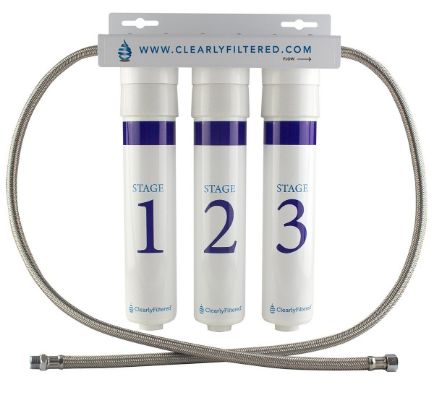
Clearly Filtered Under Sink Filtration System
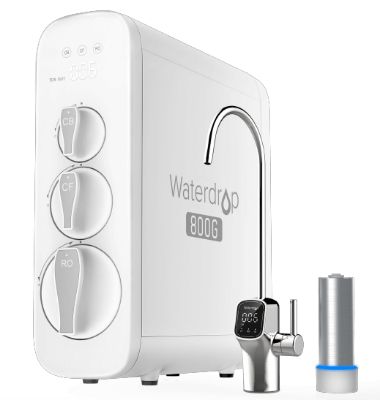
Waterdrop G3P800
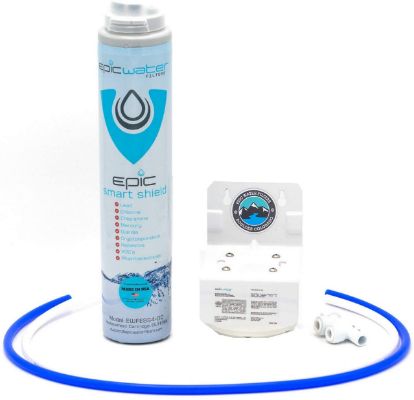
Epic Smart Shield
In today’s market, choosing the right under-sink water filter can be a daunting task. The options are plentiful, and it seems like every system out there boasts unique features and promises. If you don’t class yourself as a water filter expert, you’re probably scratching your head, wondering which filters are actually worth your money, and which are all talk, no action.
At WaterFilterGuru.com, we understand the importance of quenching your thirst with kitchen faucet water that’s free from harmful contaminants. Our team has rigorously tested and evaluated numerous under-sink water filters to bring you the best in the market. We’ve considered factors such as the number of contaminants removed, filtration speed, durability, and overall value for money.
Whether you’re looking to replace an existing filter or you’re a newcomer seeking the best protection for your household, you should find the information you need in this comprehensive resource. We’ve shared our personal reviews of the best under-sink water filtration systems across a range of categories, for a range of different situations and preferences.
Table of Contents
🥇 Best Under Sink Water Filtration Systems
- Our Top Pick: Clearly Filtered Under Sink Filtration System
- Best Tankless RO: Waterdrop G3P800
- Runner Up: Epic Smart Shield
- Best Conventional RO: Cloud RO
- Also Great: Aquasana AQ-5300
- Budget Pick: AO Smith AO-US-200
📊 Under Sink Water Filters Comparison Chart
| System | Clearly Filtered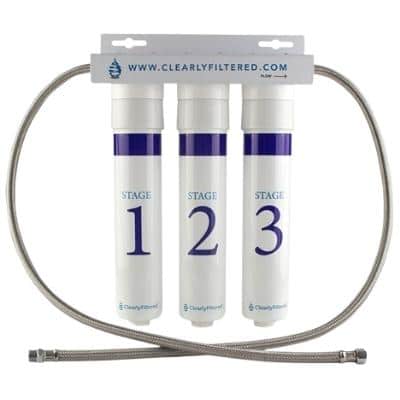 | Waterdrop G3P800 | Epic Smart Shield | Cloud RO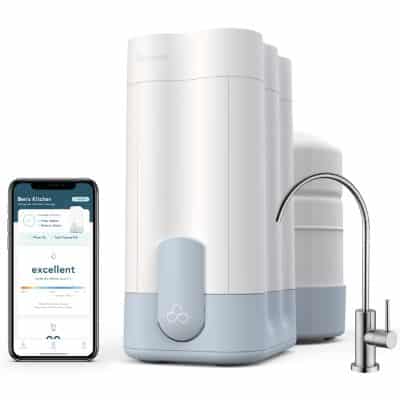 | Aquasana AQ-5300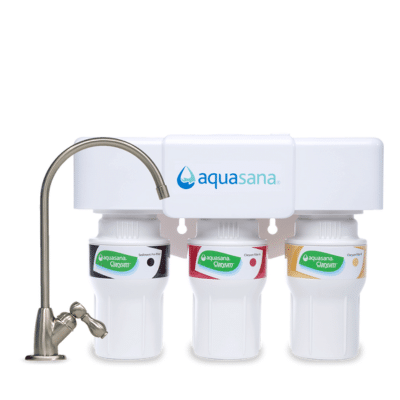 | AO Smith AO-US-200 |
|---|---|---|---|---|---|---|
| Ranking | 1st | 2nd | 3rd | 4th | 5th | 6th |
| Ratings | 5/5 | 5/5 | 4.5/5 | 4.5/5 | 4/5 | 4/5 |
| Price | $550 | $999.00 | $108 | $550 | $164.99 | $139 |
| Contaminants Reduced | 232+ | 1,000+ | 70 | 1,000+ | 77 | 77 |
| Certifications or Testing | NSF 42, 53 & 401 | NSF 42, 53, 58 & 372 | NSF 42, 53 & 401 | NSF 42, 53, 58 | NSF 42, 53 & 401 | NSF 42, 53 & 401+P473 |
| Filter Capacity | 2,000 Gallons | 6, 12, 24 months | 651 Gallons | 6-12 months | 600 Gallons | 500 Gallons |
| Annual Cost | $396-$440 | ~$145 | ~$115 | ~$115 | ~$130 | ~$120 |
| Warranty | Lifetime | 1 year | Lifetime | 1 year | 1 year 90 day guarantee | 1 year |

Clearly Filtered Under Sink Filtration System
In our opinion, the best overall under-sink water filter is the Clearly Filtered Under Sink Filtration System, designed to offer a comparable performance to a reverse osmosis system, without the negatives of RO treatment (such as water waste and mineral loss). Not only is this under-sink water filter system tested to NSF Standards for reducing 232 contaminants (that’s more than any other non-RO under-sink filter on this list), but the filters last for 2,000 gallons, or up to 12 months.
Specs
| Price | $550 |
| Contaminants Reduced | 232+ |
| Certifications or Testing | NSF 42, 53 & 401 |
| Filter Capacity | 2,000 Gallons |
| Annual Cost | $396-$440 |
| Warranty | Lifetime |
There were a couple of reasons why we were so keen to test this system: it’s the best we’ve come across for contaminant removal in its category, and we were already fans of Clearly Filtered as a company, having tested (and been blown away by) the Clearly Filtered Water Pitcher. Despite its next-level performance, this under-sink system apparently only reduces water flow by 20%. Plus, it’s backed by a lifetime guarantee and a 30-day worry-free trial – two great signs that the manufacturer is confident in the quality of the product.
First, let’s discuss what we received, and how much it cost. The Clearly Filtered Under-Sink System combines three stages of under-sink water treatment, and when we got it to review, it cost around $495. Our order included three initial filters: the priming carbon filter, the fluoride filter, and the heavy metals and VOC filter. We expected to spend around $200 a year on replacement filters – they last up to 2,000 gallons, which equates to around 12-15 months for us (this depends on your water usage).
Best For:
Anyone who can stretch their budget to the best under-sink water filter available today, which removes more contaminants than any other similar filter and is sturdily built for long-lasting filtration.
What We Like:
- Removes more contaminants than any other under-sink non-RO system we’ve tested
- No dedicated faucet required, simple install
- Independently tested to NSF Standards
- Filters last a long time
What We Don’t Like:
- Expensive
- Some interruption to water flow
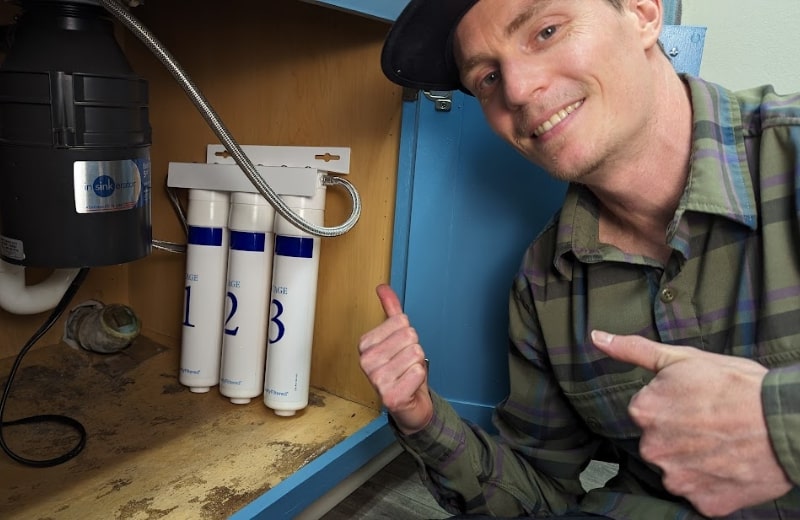
Easy to Install & Use
Of all the under-sink systems we tested, the Clearly Filtered Under Sink Filtration System was one of the quickest and easiest to install, taking just over 20 minutes from start to finish. We didn’t have to fuss about with a waste line, and the unit can be used with an existing faucet, which eliminated the need to drill a hole in our countertop for a separate faucet. All we needed were the components that were shipped in the box, a wrench, and some Teflon tape for sealing the connections.
Once the installation was complete, we could access filtered water at any time by turning on our faucet. Having tested our fair share of countertop water filters in the past, we appreciated the simplicity of using an under-sink system, which doesn’t need to be filled manually in advance. The filter replacement process is easy, too – filter cartridges are designed to twist on and off the filter housing, with no need to disassemble the system to access them.
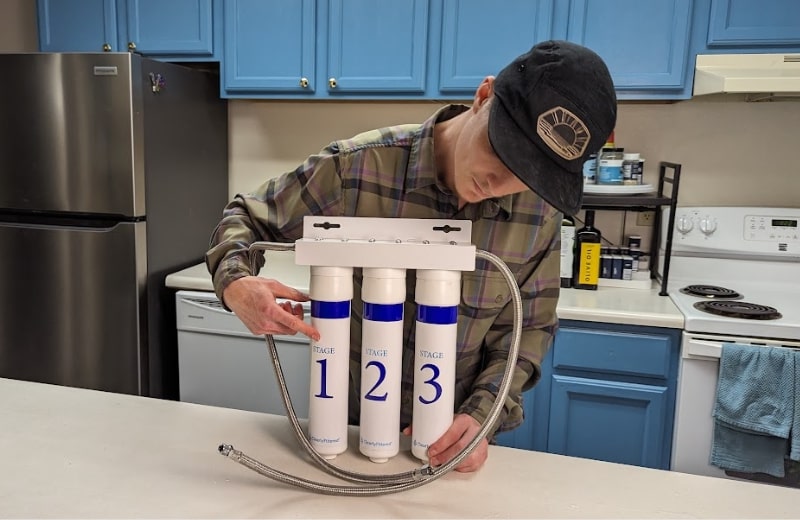
Thorough Drinking Water Purification
Most under-sink water filters we’ve reviewed can remove up to a dozen contaminants. Before the Clearly Filtered system, the best under-sink water filter we could find was the Aquasana AQ-5300 (reviewed later in this guide), which can remove 77 contaminants. The Clearly Filtered Under Sink Filtration System knocks its competitors out of the park with the ability to reduce or remove 232 contaminants, including chlorine, lead, fluoride, PFAS, pharmaceuticals, VOCs, and pesticides. The system has been tested by EPA-accredited laboratories for its contaminant removal abilities, and it has a couple of official WQA certifications: a performance certification to NSF/ANSI Standard 42 (for the reduction of chlorine taste and odor) and a certification to NSF/ANSI Standard 372 (for lead-free design). The company’s independent lab results were easily accessible to us on the Clearly Filtered website – something we appreciated given that we think transparency is an important mark of trust in a manufacturer.
Aside from contaminant removal, we also tested to see how this Clearly Filtered model affected our kitchen faucet water flow. It took us around 4 seconds to fill a glass with our high-flow faucet pre-installation. After we’d installed the unit, our water flow was reduced by around 50%, and we filled a glass in 8 seconds. We also did a taste-test comparison of our filtered and unfiltered water to see if we could notice a difference in the water quality. The filtered water definitely had a purer taste, and we couldn’t detect any chlorine. We’re hoping to update this review soon once we’ve done a tap water quality test to see what the system could remove from our own water supply.
Read the full review: Clearly Filtered Under Sink Filtration System Review

Waterdrop G3P800
The Waterdrop G3P800 is the best reverse osmosis system for under-sink installation that we’ve tested. It’s a tankless unit that purifies an under-sink water supply by removing more than 1,000 contaminants with 7 stages of superior RO filtration.
Specs
| Price | $999.00 |
| Contaminants Removed | 1,000+ |
| Certifications or Testing | NSF 42, 53, 58 & 372 |
| Filter Capacity | 6, 12, 24 months |
| Annual Cost | ~$145 |
| Warranty | 1 year |
We had the opportunity to test the Waterdrop G3P800 on our own water supply in Parker, CO. Out of the box, the system is sleek and surprisingly small, given that it packs 7 filter stages (distributed over 3 separate filter cartridges). A setback of many conventional under-sink reverse osmosis systems we’ve tested is that they take up a lot of space with a tank, but the G3P800 is tankless, so it had pretty much the same footprint as the Clearly Filtered system. Why doesn’t this unit need a tank? It has an ultra-fast 800-gallon-per-day water production rate (we’ve never actually tested a system in this category with a faster GPD rate) so we could enjoy filtered water on demand without the long wait of a slower-flow system.
As far as reverse osmosis systems go, the G3P800 is definitely an investment, costing around $1,000 upfront. We also accounted for the 3 filter changes, which, we estimated, would set us back just over $150 per year. It’s expensive, for sure, but for the reassurance of knowing for certain that we were removing virtually everything from our water, we felt it was a price worth paying.
Best For:
Folks with bigger budgets who want to invest in the most capable, efficient under-sink reverse osmosis system to purify their drinking water supply.
What We Like:
- Eliminates virtually all drinking water impurities
- Fast 800 GPD purification rate
- Superior 3:1 pure-to-drain ratio
- Space-saving tankless design
What We Don’t Like:
- Expensive
- Remineralization costs extra
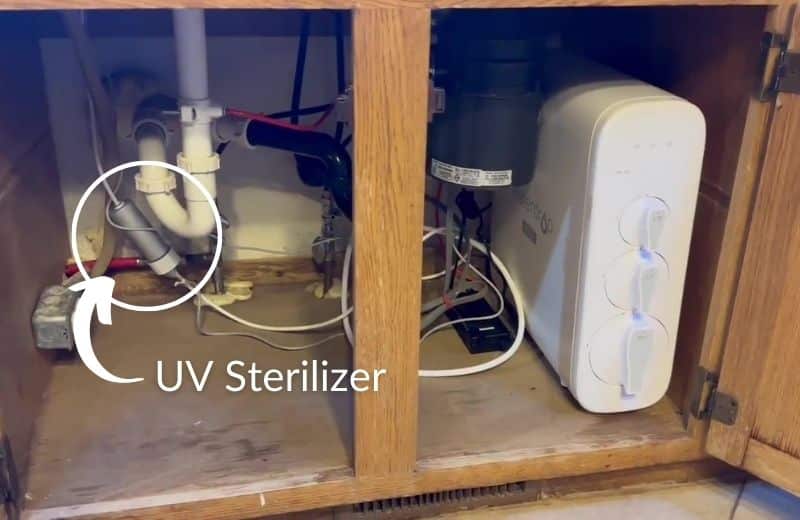
Unbeatable Reverse Osmosis Filtration
There’s no denying that the Clearly Filtered system is highly capable when it comes to contaminant removal – but as a reverse osmosis system, the Waterdrop G3P800 knocks it out of the park, being able to remove more than 1,000 impurities. We were able to perform a before-and-after tap water quality test on the system, and our purified water contained 82% less TDS and 100% less lead, fluoride, arsenic, chloride, and other dangerous contaminants. Plus, 90% of barium and 82% sodium were eliminated from our water. We also saw a reduction in pH from 7.3 to 6.3 (buying the post-alkaline filter is a good way to prevent pH drops).



See our 3rd party laboratory testing data for the Waterdrop G3P800 below.
| Contaminant | Measurement | Pre-Install | Post-Install | % Change |
|---|---|---|---|---|
| Total Dissolved Solids | PPM | 84 | 15 | -82.14% |
| Arsenic | PPM | 0.0029 | 0 | -100.00% |
| Barium | PPM | 0.0283 | 0.0033 | -88.34% |
| Calcium | PPM | 20.2 | 2.6 | -87.13% |
| Chloride | PPM | 2.2 | 0 | -100.00% |
| Copper | PPM | 0.203 | 0 | -100.00% |
| Fluoride | PPM | 0.3 | 0 | -100.00% |
| Lead | PPM | 0.0008 | 0 | -100.00% |
| Magnesium | PPM | 2.13 | 0.27 | -87.32% |
| Manganese | PPM | 0.0048 | 0 | -100.00% |
| Nitrate (as N) | PPM | 1.1 | 0.1 | -90.91% |
| Potassium | PPM | 2.12 | 0 | -100.00% |
| Selenium | PPM | 0.0015 | 0 | -100.00% |
| Sodium | PPM | 9.33 | 1.65 | -82.32% |
| Strontium | PPM | 0.199 | 0.025 | -87.44% |
| Sulfate | PPM | 7.8 | 0 | -100.00% |
The G3P800 had a smarter design than many of the non-RO systems we tested. We appreciated knowing exactly when to buy replacement filters thanks to the built-in filter life tracker, and we could see at a glance whether the system was working properly by checking the TDS trackers.
Efficient Performance
One of the defining differences between the Waterdrop G3P800 and any of the non-RO under-sink systems we tested is that the G3P800 wastes water. Wastewater production is an unavoidable side effect of RO purification, but when it comes to exactly how much water is wasted, not all systems are equal.
Conventional under-sink reverse osmosis systems typically waste 4 gallons of water for every 1 gallon of water purified. Thankfully, the G3P800 offers almost the reverse of this, wasting just 1 gallon of water per 3 gallons purified. This is one of the best efficiency ratios we’ve ever seen on an under-sink reverse osmosis system.
The fact that the system wastes water means we had an extra installation task: installing the drain line and routine it to our nearest drain pipe. This was pretty complex, and, combined with the fact that we also had a dedicated faucet to install, the overall process took around 15-20 minutes longer than installing a non-RO system. There are eight pages of the user manual dedicated to the installation process, and we recommend scanning through the steps if you’re keen to buy this system – you might decide to hire a plumber for the job.
Read the full review: Waterdrop G3 P800 Reverse Osmosis System Review
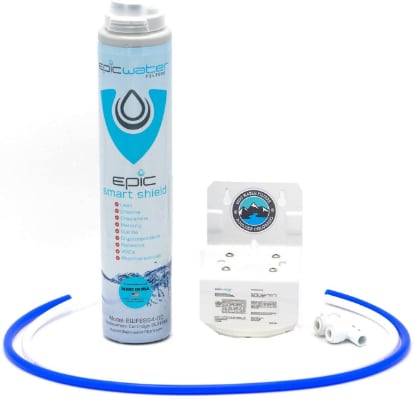
Epic Smart Shield
The Epic Smart Shield is our runner-up under-sink water filter unit. This under-sink water filter has been certified by IAPMO to remove up to 99.99% of 70 different tap water contaminants, and is a fraction of the price of the Clearly Filtered unit, costing around $135. It also has a long filter life – filters only need replacing every 12 months or so.
Specs
| Price | $108 |
| Contaminants Removed | 70+ |
| Certifications or Testing | NSF 42, 53 & 401 |
| Filter Capacity | 651 Gallons |
| Annual Cost | ~$115 |
| Warranty | Lifetime |
All our other top picks for under-sink systems have three separate filter stages. But we know some folks don’t want the hassle or expense of replacing three different filter cartridges, and prefer to take up as little under-sink space as possible. The Epic Smart Shield has a much simpler design: it came with just a handful of components, including the filter, the wall mount, the flexible tubing for connecting it to our water line, and several separately packaged nuts, heavy-duty velcro, and screws.
The upfront cost has crept up slightly since our testing: the Smart Shield cost around $120 when we first reviewed it a couple of years ago, and (at the time of writing this updated review) it now costs $135. Or, we could pay just $108 upfront for subscribing to Epic’s Clean Water Club, which means you’ll receive replacement filters every 12, 16, 18, or 24 months according to your pre-determined schedule, also at 20% off the usual price (around $95 rather than $120). Given that filters last up to 12 months, our projected annual spend was around the $120 mark.
Best For:
Folks looking for a lower-cost single-stage under-sink tap water filter that’s ANSI certified to remove many of the common drinking water contaminants.
What We Like:
- Better priced for smaller budgets
- Certified performance
- Removes 70+ contaminants
- Easy install & maintenance
What We Don’t Like:
- Doesn’t remove as many contaminants as our other top picks
- Water flow gets quite slow
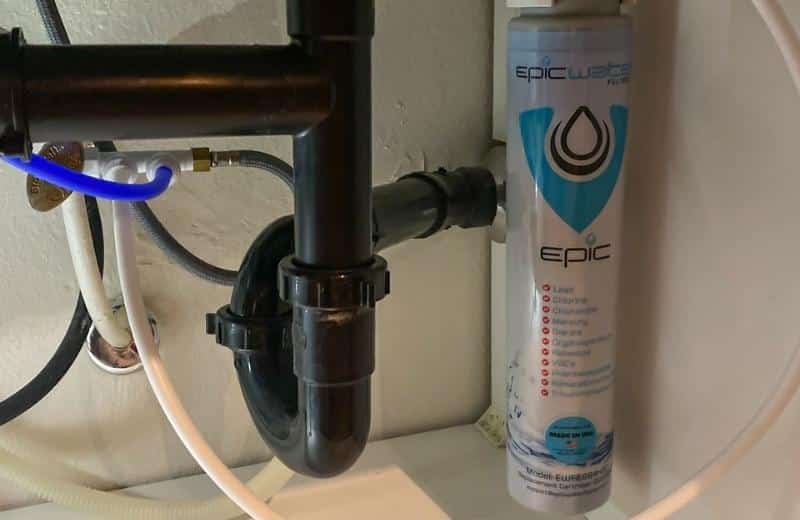
Certified to Remove 70+ Contaminants
We wanted to find a budget-friendly under-sink water filtration system that wouldn’t let us down with its performance. Contaminant removal was obviously the most important factor for us, and from the start, we could feel confident in Epic’s claims that the Smart Shield can remove 70+ contaminants. Why? Because it’s been triple-certified by IAPMO – so straight away, we had official proof of performance. The unit holds an NSF Standard 42 certification, for the removal of both chlorine and chloramine, taste, odor, and Particulate Class I; an NSF Standard 53 certification, for the removal of asbestos, cysts, lead, mercury, VOCs, and more; and an NSF Standard 401 certification, for the reduction of BPA and pharmaceuticals. You can download Epic’s datasheets to see exactly what the Smart Shield can remove here and here.
The Smart Shield’s performance certifications are especially impressive given that the system only uses one filter stage, which means it has less opportunity to tackle a broader range of contaminants with different filtration processes. Made from sustainable activated coconut carbon, the filter cartridge uses the adsorption filtration process to trap impurities in its pores. We’ve tested enough water filters to know that you usually can’t go wrong with activated carbon, and in Epic’s case, it offers two-in-one benefits: our water safety was improved, and our water tasted significantly cleaner and purer, with no chemical aftertaste.
A few comments on general use and performance: we found the Smart Shield under-sink water filter easier to install than most of the other systems we tested, and it took us under 15 minutes from start to finish. We did a flow rate test before and after installing the system and found that while our flow rate was slower, it wasn’t annoyingly so. Before installing the filter, it took us just under 4 seconds to fill a glass with water. After installing the filter, it took us 6 seconds to fill a glass. We did notice, however, that the flow rate became slower and slower as we continued to use the system over the months, while other systems we tested had more consistent flow rates throughout their filter lifespans.
Read the full review: Epic Smart Shield Under Sink Filter Review

Cloud RO
We’ve found that the best conventional under-sink reverse osmosis system is the Cloud RO system – our top pick for the best RO system in this category. This tank-based unit offers the same exceptional performance as the G3P800, our other under-sink reverse osmosis recommendation. The manufacturer is currently in the process of getting the system certified to NSF 58 and it already has third-party testing to NSF 42 and 53.
Specs
| Price | $550 |
| Contaminants Removed | 1,000+ |
| Certifications or Testing | NSF 42, 53, 58 |
| Filter Capacity | 6-12 months |
| Annual Cost | ~$200 |
| Warranty | 1 year |
While both the Cloud RO and the Waterdrop G3P800 are under-sink reverse osmosis systems, we identified a few key differences between them. First, the Cloud RO is tank-based, which means it stores purified water in a tank and gives you instant access to this water when you turn on the faucet. It has a much slower water production rate of 80 GPD, but this isn’t as important given that water will always be available in the tank when you need it (however, a slower water flow is often linked to more water waste, as is the case when comparing this system to the G3P800).
We reviewed the Cloud RO during a holiday sale, which knocked $200 off its usual upfront cost of $750, bringing the price down to $550. The unit uses four separate filter cartridges – sediment, activated carbon, and reverse osmosis filters, and an alkalizing post-filter – and we estimated that our annual maintenance spend on filter changes would be just under $200.
Best For:
People looking to remove as many contaminants as possible from their kitchen sink water and prefer a conventional tank-based system with an included remineralization stage.
What We Like:
- Eliminates nearly all contaminants
- Smaller, smarter, and more attractive than similar tank-based systems
- Tank-based design provides purified water instantly
- App connectivity
What We Don’t Like:
- Expensive
- Not as efficient as some modern systems
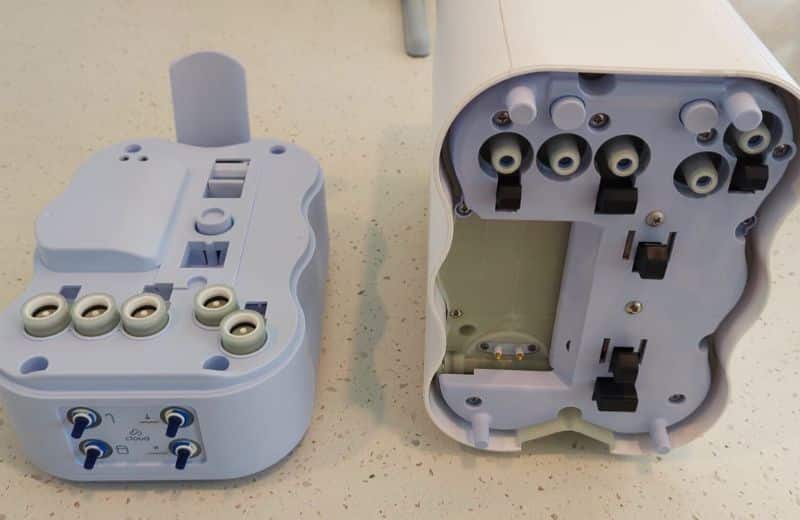
Tank-Based Reverse Osmosis Purification
The Cloud RO is the only under-sink water filtration system on this list that comes with a storage tank, meaning that it takes up more cupboard space than any other system we reviewed. But the storage tank has one key advantage: it sends water straight to your faucet when you switch it on, so you don’t have to wait for it to travel through the filters first. This is good news for The Cloud RO given that it has four separate filter stages and a pretty slow 80 GPD water production rate.
Speaking of the filters, they’re rated to reject up to 95% TDS before re-introducing healthy minerals to the water, improving its quality, purity, and taste. We read the datasheet shared by the manufacturer, and the contaminants removed are endless – including 38 chemicals, 20 pesticides, 18 inorganic contaminants, 11 heavy metals, 8 biologicals and particulates, 8 pharmaceuticals, and 6 water disinfectants. The only thing that’s missing for us is an official performance certification, which the manufacturer is still in the process of obtaining. For now, we’re pleased with the third-party testing obtained for the sediment and carbon filters to NSF Standard 42, and we’re hoping to conduct our own in-house water quality test to see exactly what this system can remove from our own water supply.
The Cloud RO unit has a 1:1 efficiency ratio, which doesn’t quite match up to the Waterdrop tankless model’s 3:1 efficiency ratio. It means 1 gallon of water will be wasted for every 1 gallon purified, which is still one of the best ratios we’ve seen for a conventional tank-based system. That said, you’ll need to accept that your wastewater production will be higher with this system.
The Cloud RO is unique in that it runs using a long-lasting battery pack, rather than needing to be plugged into a power source. Having a working battery is important – it enables you to access the system’s smart features, including the TDS, filter lifespan, and flow rate trackers. There’s a dedicated slot in the unit for the battery, and a new battery is shipped with every set of filter replacements. Old batteries can be returned to the manufacturer for recycling.
Read the full review: Cloud RO Review
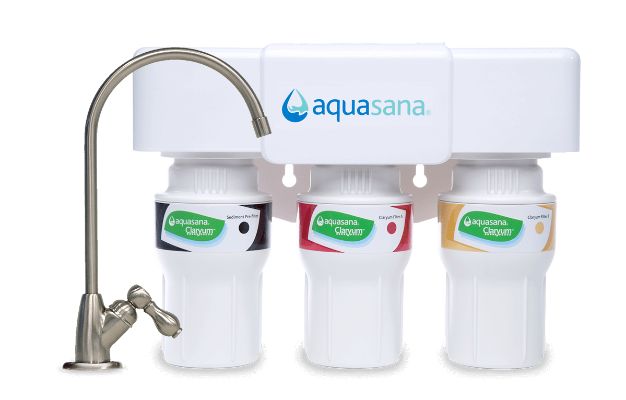
Aquasana AQ-5300
The Aquasana AQ-5300 filter is another of our top recommended under-sink filtration systems. This three-stage system might not remove as many contaminants as the Clearly Filtered unit, but it holds an official NSF certification for Standards 42, 53, and 401 for its ability to remove chlorine, chloramine, VOCs, lead, pesticides, herbicides, and more. It’s also certified to remove PFOA and PFOS – a rare performance certification amongst under-sink water filters.
Specs
| Price | $164.99 |
| Contaminants Removed | 77+ |
| Certifications or Testing | NSF 42, 53 & 401 |
| Filter Capacity | 600 Gallons |
| Annual Cost | ~$130 |
| Warranty | 1 year, 90-day guarantee |
The AQ-5300 is a 3-stage system, like the Clearly Filtered system. Aside from contaminant removal, we identified a couple of other key differences between the two: the AQ-5300 has a slower 0.5 GPM flow rate, and it comes with its own dedicated faucet that’s guaranteed to be lead-free – but does require a slightly more complex installation.
Aquasana was holding a sale for the system when we reviewed it – it was selling for around $175. We could choose between chrome, brushed nickel, and oil-r\ubbed bronze faucets (at no extra cost). We expected to spend around $130 on annual filter replacements – the filters’ average lifespan is lower than the Clearly Filtered system’s (6 versus 12 months), but the AQ-5300 filters are cheaper to replace.
Best For:
Anyone who has a smaller budget and wants to buy an under-sink water filter that’s NSF certified to remove more contaminants than any other NSF-certified under-sink system we’ve reviewed.
What We Like:
- Removes 77 common contaminants
- WAQ certified performance
- More affordable than the Clearly Filtered system
- Multiple faucet styles to choose from
What We Don’t Like:
- Dedicated faucet requires extra installation steps
- Filter life isn’t as long as Clearly Filtered’s
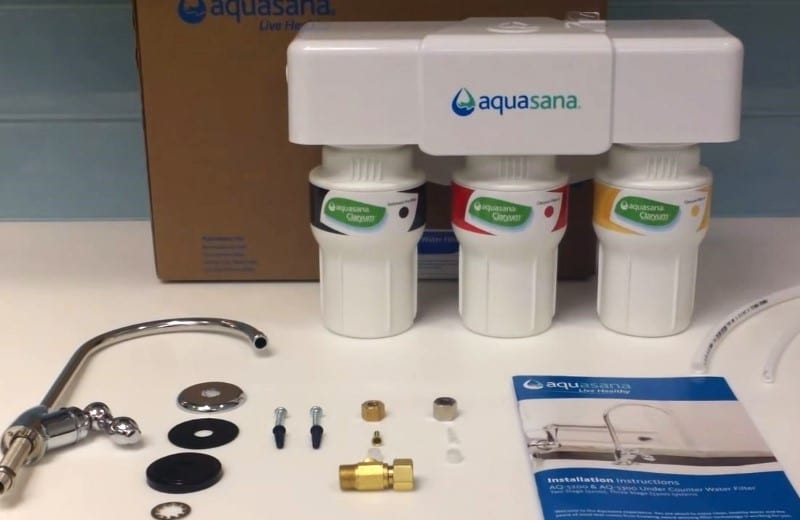
WQA Certified Performance
The AQ-5300 combines a pre-sediment filter with a catalytic and granular activated carbon filter and Aquasana’s Claryum® technology. It’s shorter than the Clearly Filtered unit, making it a good option for under-sink setups with minimal available space. Aside from that, it’s pretty much the same in design apart from the fact that it comes with a dedicated faucet. If you don’t already have a hole in your countertop (such as one for a soap dispenser), you’ll need to drill one to install this system.
We knew that the Aquasana AQ-5300 hadn’t been tested to remove as many contaminants as the Clearly Filtered system. However, it has been officially certified by the WQA to 4 NSF Standards, for its ability to remove 77 contaminants – something that sets it apart from Clearly Filtered’s under-sink offering, which has just one NSF performance certification. These include a WQA certification to NSF Standard 53, for the removal of heavy metals like lead, as well as PFOS, PFOA, asbestos, and chloroform; NSF 401, for the removal of emerging and incidental contaminants, like BPA and pharmaceuticals, and NSF 42, for the removal of chlorine, taste, odor, and Particulate Class I. The AQ-5300 is our top recommendation for anyone who wants the reassurance of an under-sink water filter that has been officially performance-certified for its ability to remove a broad range of contaminants.
As for flow rate, we’ve found that most under-sink systems have a flow rate of 0.75-1 GPM on average, so the AQ-5300’s 0.5 GPM rated flow is a little on the slow side. Aquasana sells a Max Flow version of the system with a rated service flow of 0.72 GPM, but it costs an extra $50, so it’s not worth it in our eyes. However, most folks will only be using the system for their drinking water, anyway, since it comes with its own faucet. You can use your own faucet whenever you want a faster flow of water that’s not for drinking purposes, such as washing dishes.
Read the full review: Aquasana AQ-5300 Review
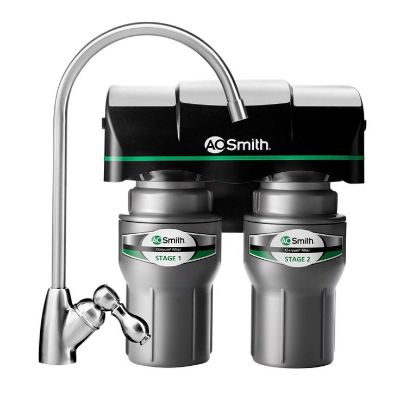
AO Smith AO-US-200
Our best budget-friendly under-sink water filter on this list is the AO Smith AO-US-200. This water filtration system has WQA certified to NSF Standards 42, 53, 401 +P473 to remove 78 contaminants including lead, asbestos, mercury, chlorine, pharmaceuticals, and pesticides. The system has a 500-gallon capacity, requiring a filter replacement every six months or so.
Specs
| Price | $139 |
| Contaminants Removed | 78+ |
| Certifications or Testing | NSF 42, 53 & 401, +P473 |
| Filter Capacity | 500 Gallons |
| Annual Cost | ~$120 |
| Warranty | 1 year |
The AO-US-200 is a 2-stage under-sink system, so it offers more opportunity for trapping a broader range of contaminants than a 1-stage unit, but it doesn’t quite have the commitment of a 3-cartridge system. Good news if you don’t want to risk leaching contaminants back into your water post-filtration: there’s a dedicated faucet included with this water filtration system, which comes in a polished chrome finish.
The system currently costs around $139, which is similar to the cost of the Epic Smart Shield, except in this case, there are two separate filter cartridges involved. Our projected annual cost of $120 for maintenance – again, for two filters – also felt fair.
Best For:
Anyone who wants the reassurance of a certified performance but doesn’t want to spend a fortune upfront on an under-sink system.
What We Like:
- Affordable upfront & ongoing costs
- Officially performance certified
- Removes 78 contaminants
- Dedicated faucet eliminates the risk of leaching post-filtration
What We Don’t Like:
- Longer install process due to faucet installation
- A few customers had issues with leaking
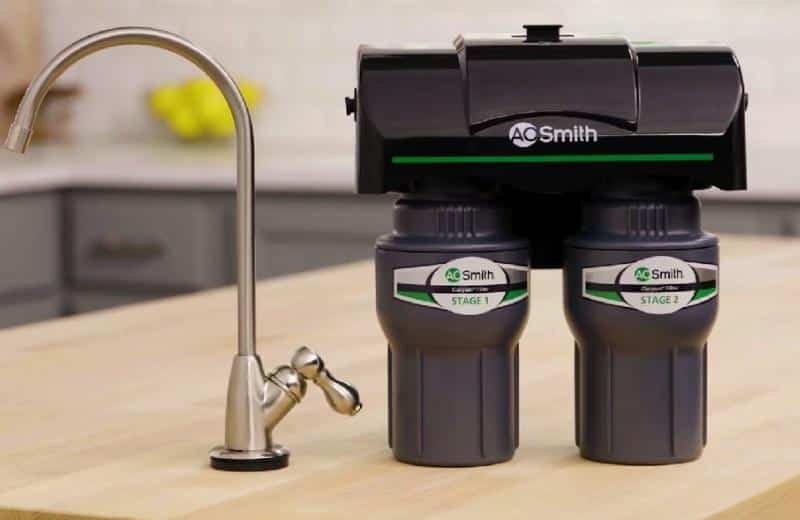
Two-Stage Certified Under-Sink Filtration
There’s something our top non-RO under-sink systems have in common: they’re all certified to at least one NSF performance standard. Even AO Smith, offering a lower-cost product and therefore getting less back in return, invested in getting the AO-US-200 WQA certified to 3 NSF Standards: NSF/ANSI 42, for the reduction of chlorine, taste, odor, and Particulate Class I; NSF/ANSI 53, for the reduction of contaminants with health effects, including asbestos, lead, mercury, and volatile organic compounds; and NSF/ANSI 401, for the reduction of emerging and incidental contaminants, including BPA and pharmaceuticals. We noted that the water filtration system is also certified to reduce PFOS and PFOA under NSF 53 – a rarity among water filters, especially budget-friendly models.
Like in the Aquasana model, the filters in this system are Claryum filters, which combine carbon block filter media with catalytic carbon, ion exchange, and absolute sub-micron mechanical filtration. The unit has a flow rate of 0.5 GPM. Again, that’s not the best we’ve seen, but it’s pretty standard for a conventional under-sink system. The unit measures 16.65 inches (height) by 11.1 inches (width) by 6.57 inches (depth), so it’s one of the smaller, shorter systems available for under-sink installation – a good choice if you don’t have a lot of cupboard space.
Installing the AO-US-200 is slightly more complex due to the dedicated faucet (you’ll need to drill a hole in your countertop if you don’t have one already) and the fact that you have to cut the tubing yourself, increasing the potential for mistakes. The user manual outlines the install instructions, so it’s worth checking out if you want to know whether you can tackle the process yourself.
📚 Methodology: How We Tested The Best Under-Sink Water Filter Systems
Before we began our testing and reviewing process, we outlined a number of key considerations we needed to make when ranking the best under-sink water filters. These were:
- Cost & value – Under-sink filters aren’t the most expensive systems on the market, but the cost can vary quite a bit. On average, the under-sink water filter systems we tested cost between $100 and $500, not including additional installation costs. Rather than finding the cheapest systems available, we searched for filters that offered the best value for money for their performance. Several of the systems we found cost less than $160, making them budget-friendly, and they’re the best we found within this affordable price point. We expected to pay around $100-$200 per year on filter replacements, depending on the manufacturer. We picked systems that had a good filter life of at least 6 months to reduce the frequency of spending.
- Contaminants removed – Another really important consideration for us was which contaminants our water contained, and what we wanted to remove with an under-sink water filter system. Different water supplies have different problem impurities (disinfection byproducts, lead, fluoride, and various other heavy metals were present in ours), and your best bet is to find a filtration system that can tackle as many contaminants as possible. Since contaminant removal was a priority for us, we looked for systems that exceeded our expectations in this area. Even our lower-cost shortlisted under-sink filters can remove at least 70 contaminants. Our tip: if you don’t know what you want to remove, test your water yourself or check your most recent Water Quality Report for your water utility.
- Testing and certifications – We were much more likely to shortlist an under-sink water filter for a review if it had third-party testing or official certifications for its ability to remove contaminants, since these are the biggest indicator of a water filter’s performance reliability. The best under-sink water filters we tested had an ANSI/NSF certification, or a certification to NSF Standards by IAPMO or the WQA. Common certifications amongst under-counter systems included NSF 42, for removing chlorine, tastes, and odors; NSF 53, for removing contaminants with health effects, like lead, mercury, PFOA, and PFOS; NSF 58, for broad contaminant removal with reverse osmosis; and NSF 401, for the removal of emerging contaminants, such as pharmaceuticals.
- System size & dimensions – There’s no industry-recognized size for under-sink water filters, and we considered size and dimensions before installing and testing this type of water filter. Our under-sink cupboard is roomy, but if you have a particularly low cupboard or you just don’t want your under-sink system to dominate the space, make sure to check the system’s measurements to make sure it’ll fit comfortably before you spend your money.
- Component quality & durability – The quality of a filter’s components affects durability, ease of use, and running costs, so this was another important factor we considered when testing and reviewing the best under-sink water filters for this guide. We prioritized filters with a sturdy construction, and we only reviewed those with BPA-free designs, preventing the leaching of dangerous industrial chemicals into our water.
- Installation & maintenance – We knew that different people would have different installation and maintenance preferences for an under-sink water filtration system, so we aimed to review a selection of systems for different situations. Of all the under-sink water filters we tested, the direct-connect non-RO systems without a dedicated faucet were the quickest and easiest to install (most within 15-25 minutes). Under-sink filters with their own faucet required an extra installation task, while under-sink reverse osmosis filters were the most challenging to install, requiring a drain connection. If you’re not a handy person or you hate DIY, you might need to enlist the help of a friend or family member for the job. As for maintenance, most of the systems we tested had 6-12-month filter lifespans. The easiest-to-maintain systems were those that had only one or two filters to change around once or twice a year.
- Flow rate – An under-sink filtration system intercepts your kitchen cold water feed line, so we knew that a good flow rate was an essential feature of the best under-sink water filters. We have a high-flow kitchen faucet, so we knew that our flow rate would be reduced slightly after installing an under-sink system. But we still wanted to enjoy a consistent, uninterrupted water supply at our kitchen sink. Most non-RO under-sink water filters we tested had a flow rate of 0.5-1 GPM (gallons per minute). The RO systems we tested had a flow rate of 80-800 GPD (gallons per day).
- Customer feedback & reviews – While testing, researching, and reviewing under-sink water filters ourselves was our main priority, we knew that pulling only from our own experience with a product had its limitations. We also took customer reviews into consideration when shortlisting the water filtration systems in this guide. Customer reviews helped us to understand the overall customer experience for a certain product, providing insight into quality, durability, and ease of use. In our research, we read through customer reviews, noting any trends – positive or negative – relating to users’ experiences with a filter.
Additionally, Check out the best under sink water filters for well water of 2025 right here.

❔ Frequently Asked Questions
Do under-sink water filters actually work?
Yes – if you spend your money wisely on one of the best under-sink water filters, it does actually work to remove contaminants from your tap water. We know because we’ve personally tested several of these filters with a before-and-after water quality test, which proved to us that these systems could reduce the contaminants in our water, often by 100%.
Should I get an under-counter filtering system or an RO system?
Get an under-counter water filtration system if your budget is slightly smaller and you want to remove many of the common drinking water contaminants without actually purifying your water. Get a reverse osmosis system if you have more money to spend upfront and you want a system that thoroughly remove all total dissolved solids, including bacteria, and you’re prepared for the side effects of RO purification (including water waste and demineralization).
What are the disadvantages of under-sink water filters?
Some of the disadvantages of under-sink water purifiers are that they take up your under-sink space, they only treat water at your kitchen faucet, and they have an ongoing maintenance cost – it’s not the case of buying the system and never having to spend money on it again.
How do I choose a water filter under my sink?
When choosing a water filter under your sink, consider your budget, the contaminants you want to remove, your installation and maintenance preferences, the manufacturer’s reputation and customer feedback, and whether or not the filtration system is tested or certified to any NSF Standards for design or performance.
How often do you need to change a sink water filter?
On average, you need to replace filter cartridges in a sink water filter every 6-12 months. This depends on the brand and model, so check your user manual for specific instructions.
Are under-the-sink water filters worth it?
Under-the-sink water filters are worth it for you if you have the budget for a moderate water filter and you specifically want a built-in water filtration system that will filter your water on demand, so you get clean, filtered water whenever you turn on the faucet. These systems might not be worth it for you if you have a small budget and are looking for something cheaper, or you want to filter the water in your whole home.
🤓 About Our Experts
This guide was produced by Brian Campbell, WaterFilterGuru.com’s Founder and Water Filter Specialist, and Jennifer Byrd, our water treatment specialist. Brian and Jennifer researched and reviewed our shortlisted products, and Brian tested many of the filters in his home. Check out their author bios below to learn more.




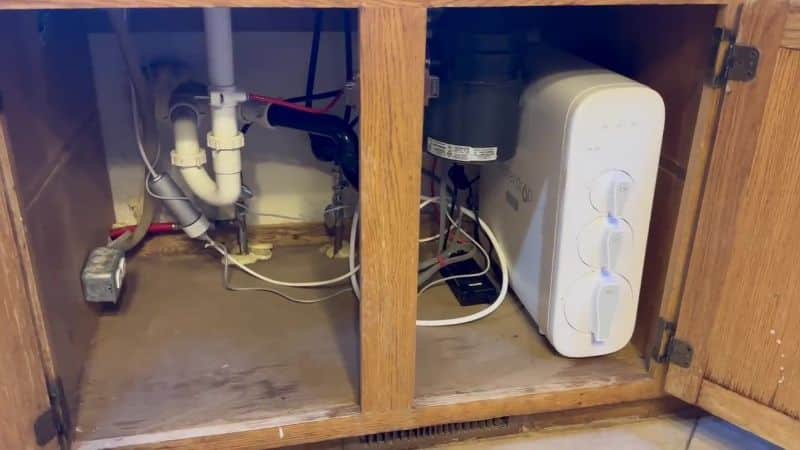
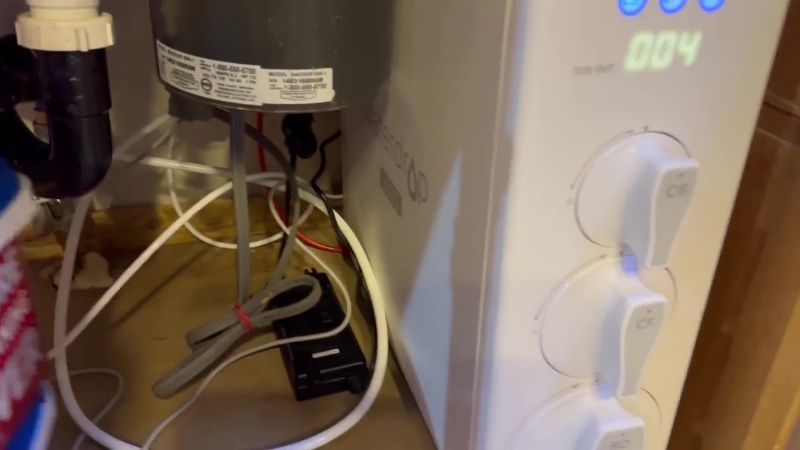
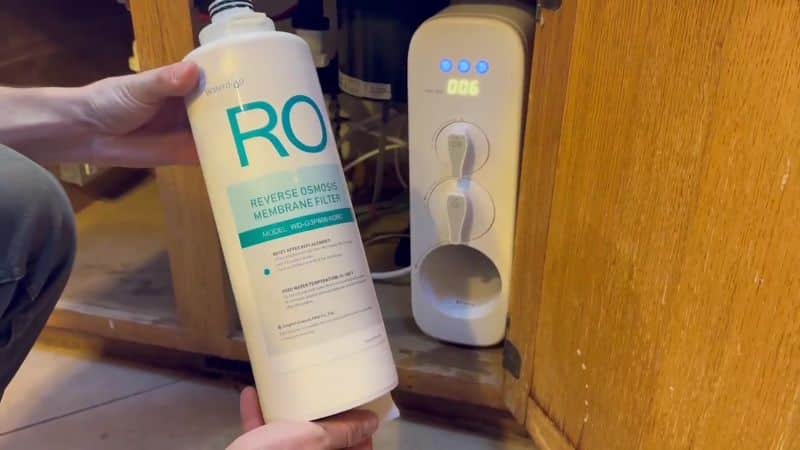
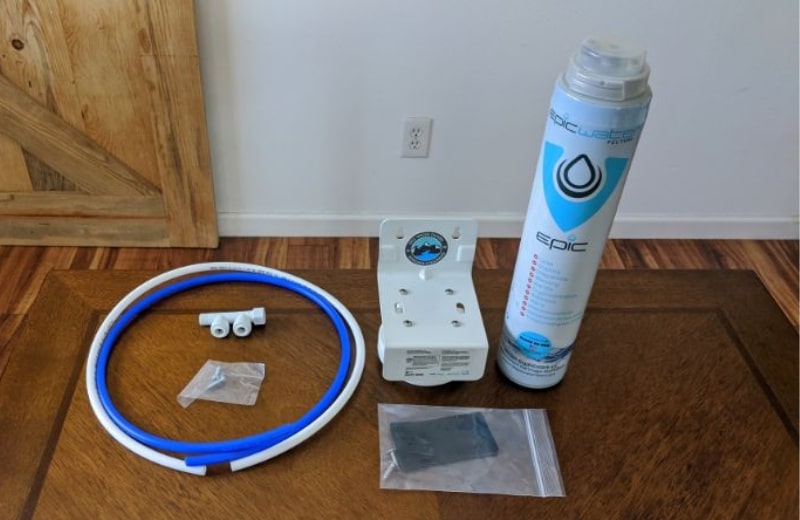
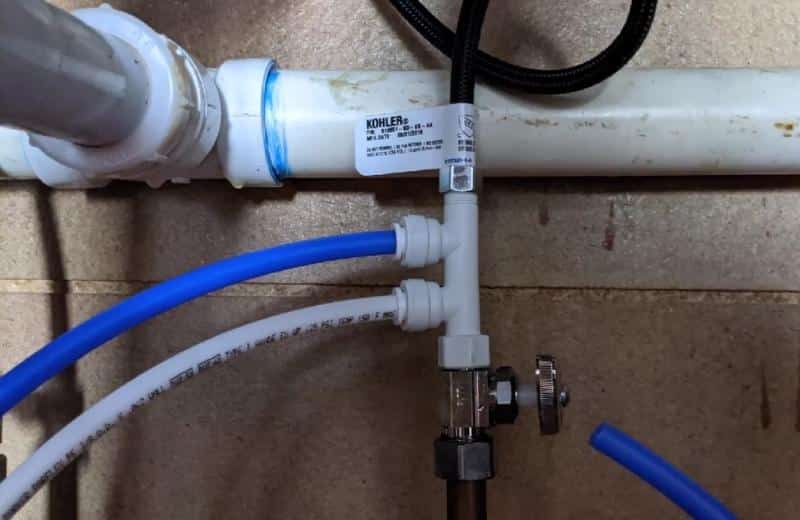
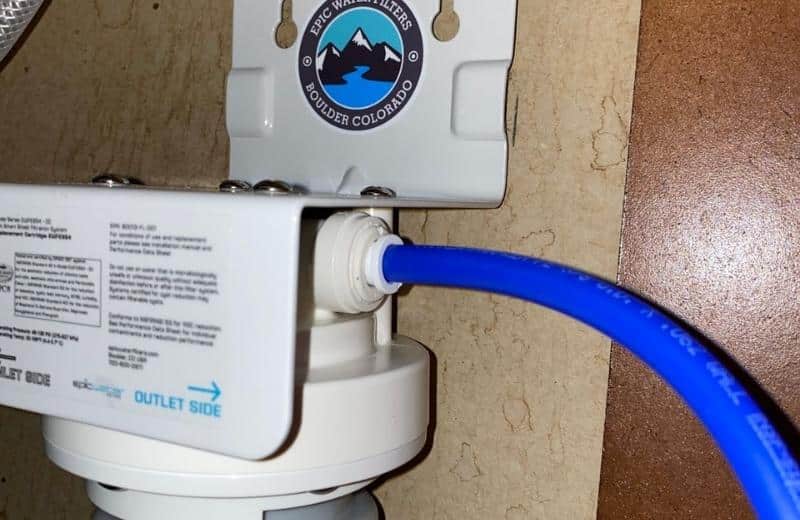
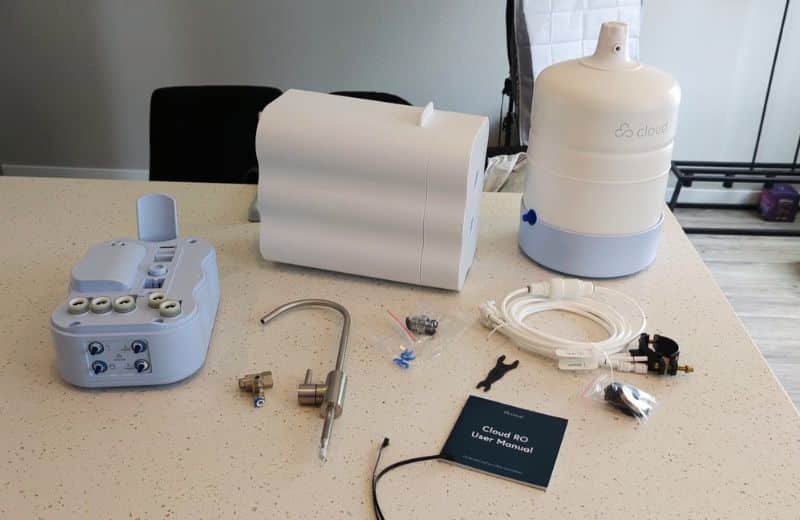
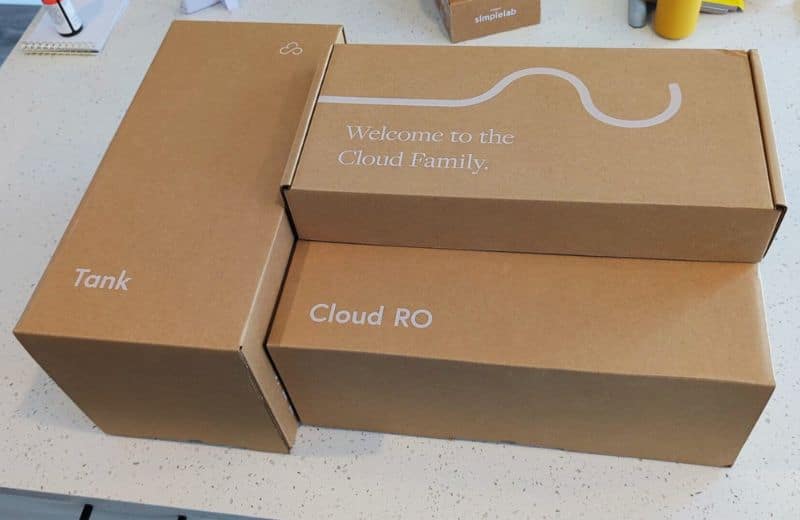
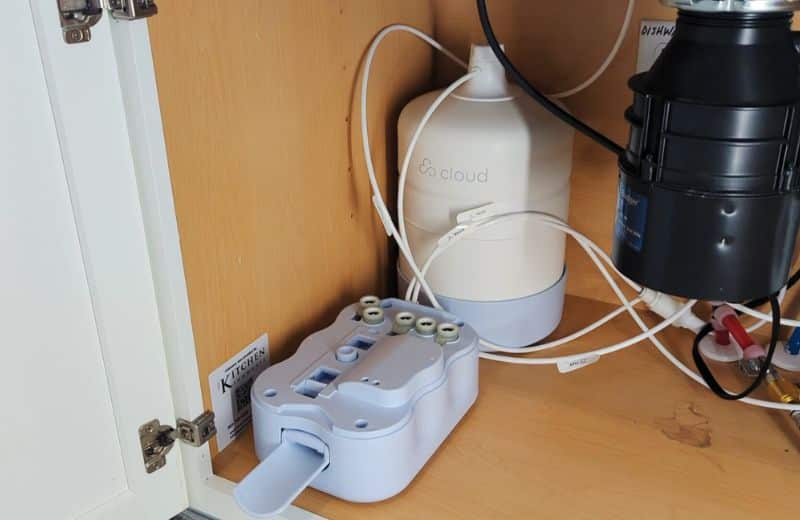
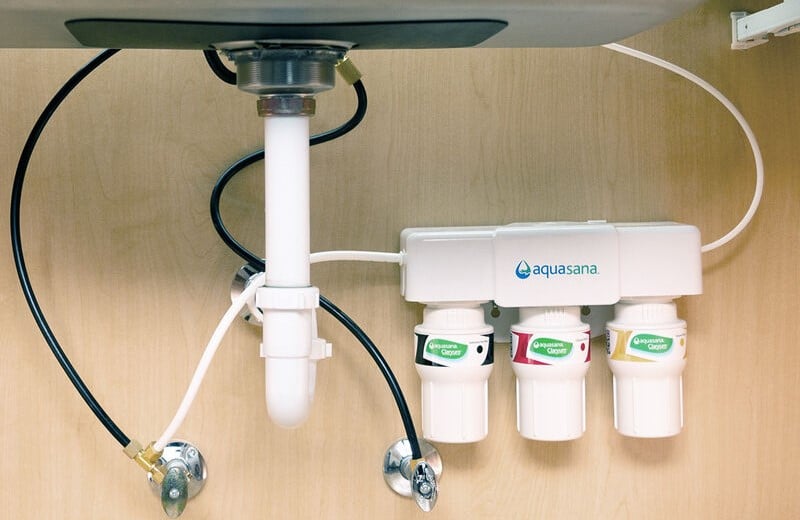
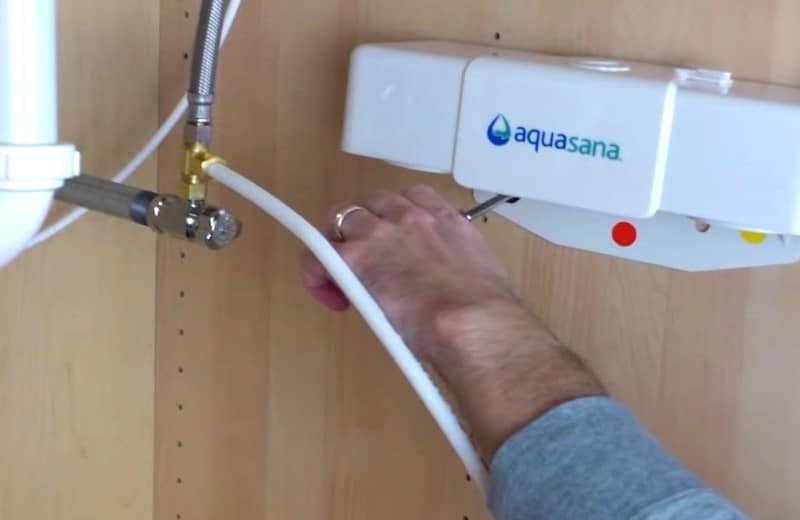
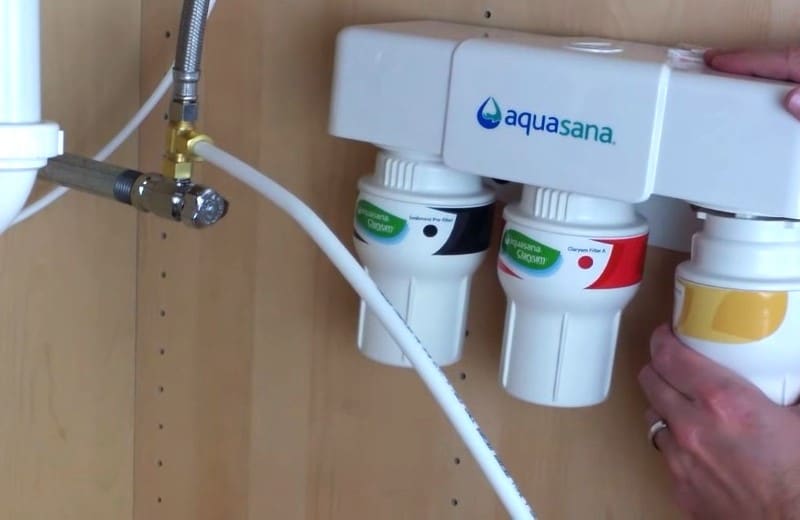

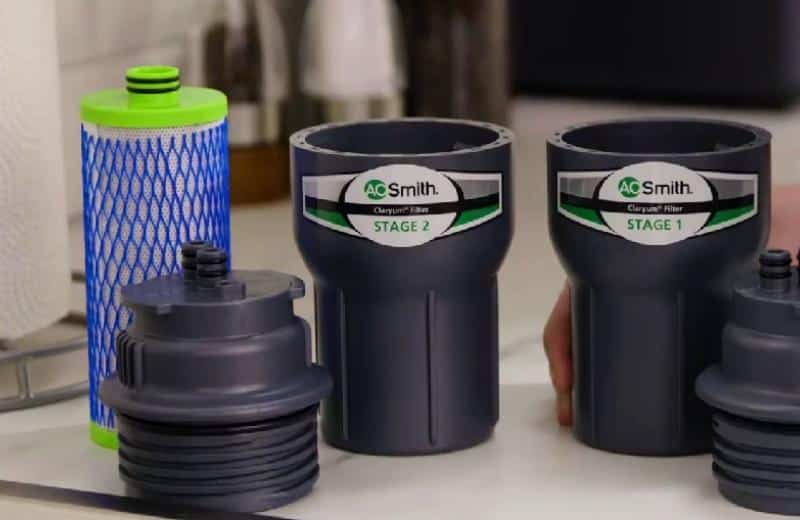
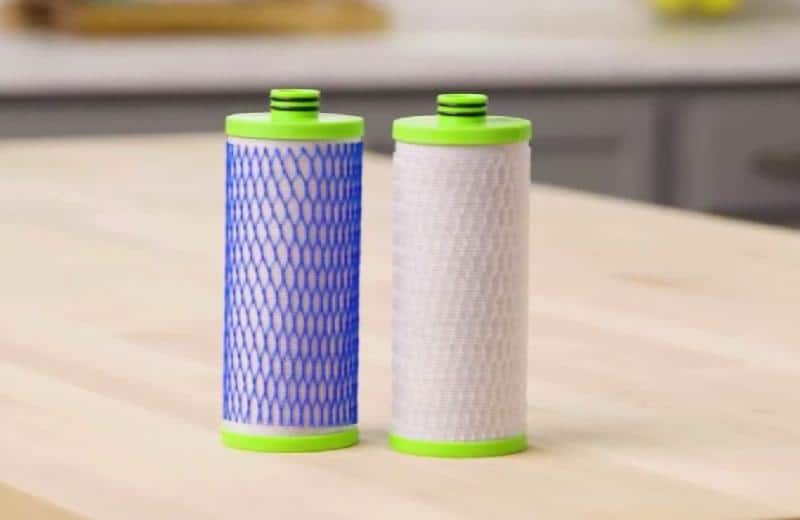
Hi, I was wondering if the Epic Smart Shield can be used under a bathroom vanity sink. If so, can the sediment attachment be used along with It?
Thank you!
Yes, as long as there is room under the bathroom sink and the plumbing connection is the right size